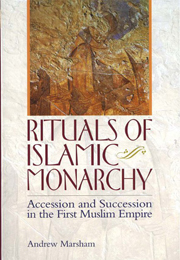Book contents
- Frontmatter
- Contents
- List of maps and figures
- Acknowledgements
- Map 1
- Map 2
- Map 3
- INTRODUCTION
- PART I LATE ANTIQUE ARABIA AND EARLY ISLAM (c. 550–c. 660)
- PART II THE UMAYYAD CALIPHATE (c. 660–750)
- PART III THE EARLY ABBASID CALIPHATE (c. 750–809)
- PART IV THE MIDDLE ABBASID CALIPHATE (809–865)
- CONCLUSION
- Genealogical table of Quraysh
- Genealogical table of the Abbasid caliphs
- Bibliography
- Index
INTRODUCTION
Published online by Cambridge University Press: 05 September 2013
- Frontmatter
- Contents
- List of maps and figures
- Acknowledgements
- Map 1
- Map 2
- Map 3
- INTRODUCTION
- PART I LATE ANTIQUE ARABIA AND EARLY ISLAM (c. 550–c. 660)
- PART II THE UMAYYAD CALIPHATE (c. 660–750)
- PART III THE EARLY ABBASID CALIPHATE (c. 750–809)
- PART IV THE MIDDLE ABBASID CALIPHATE (809–865)
- CONCLUSION
- Genealogical table of Quraysh
- Genealogical table of the Abbasid caliphs
- Bibliography
- Index
Summary
This book is a history of the rituals by which the first Muslim monarchs were formally acknowledged. Like the Christian Roman emperor and the Iranian King of Kings, the caliph of the first Muslim empire was acclaimed by his followers and received oaths of allegiance from them. He appeared before them enthroned in both religious and royal settings, bearing the insignia of his office. That the caliph was a ‘monarch’, and in some senses a ‘king’, perhaps does not need to be restated. However, the emphasis in much of Islamic political thought on the notion of ‘kingship’ (mulk) as mere earthly, or temporal power, in contrast to the legitimate authority of the ‘caliphate’ (khilāfa), which is derived from God, can obscure the important continuities between caliphal authority and that of ancient Near Eastern monarchy. Because of this distinction in the Islamic tradition, ‘monarchy’ is probably a better description of the caliphate than ‘kingship’; it encompasses the shared cultural heritage with ancient Near Eastern rulership, while acknowledging the distinctive semantic and conceptual transformations of that heritage that took place in Islam.
The monarchs of Rome, Iran and Islam each represented temporal and sacral authority in an imperial context – they were both ‘king’ and ‘priest’ of a preeminent, divinely sanctioned world power. In Islam, a division of roles between the caliph and his Muslim subjects eventually led to ‘classical’ Sunni orthodoxy (that is, the four main schools of medieval Sunni Islam), in which the right to interpret God's law (sharica) came to reside not exclusively in the person of the caliph, but rather in God's community as a whole.
- Type
- Chapter
- Information
- Rituals of Islamic MonarchyAccession and Succession in the First Muslim Empire, pp. 1 - 18Publisher: Edinburgh University PressPrint publication year: 2009



